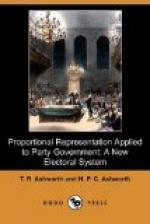1. You are allowed Six votes, and can give either one or two votes to any candidate on either list.
2. Stamp out one of the white spots if you wish to give a candidate one vote.
3. Stamp out the two white spots if you wish to give a candidate two votes.
4. Your ballot paper will be invalid if you stamp out more or less than Six white spots.
+Character of Parties.+—We must now prove that the methods proposed will actually organize the people into two coherent parties. Let us suppose either party to be composed of three sections. The problem is to induce these three sections to work together, and to sink their petty differences in the general interest, in short to unite as a party, aiming at the control of administration with a definite policy on public questions. Let us further suppose the party entitled to three representatives. Now, it is quite conceivable that exactly the same three candidates would be elected if each elector had any number of votes from one to three, and this would actually tend to be the case the more united the party is. But herein lies the difference: that with one vote only any one section holding narrow and violent views can return an independent delegate, and therefore has a direct inducement to do so, while with three votes it is forced to work with the other two sections, for if it refuses to do so it is in their power to exclude its nominee. It is this power to exclude independent factions which is the first requisite to prevent the main parties degenerating into factions. Now, the advocates of the Hare system declare that each elector should have one effective vote only, no matter how many seats the party is entitled to. The elector would therefore only express his opinion as to the delegate of his own section, and not as to the constitution of the whole party, and there would be nothing whatever to prevent the election of the favourites of sections, instead of the representatives most in general favour with all sections.
But if there were only one party it would be impossible to make all the sections work together in this manner. Some of them would combine into a majority of the party, and would exclude the minority. With two great competing parties, however, the case is quite different. So far from either party wishing to exclude any small minority, both will compete for its support, providing only that it will fall into line with the other sections on the main questions of policy. Each section will therefore support the party which will consent to embody the most favourable compromise of its demands in its policy. If its demands are such that both parties refuse to entertain




